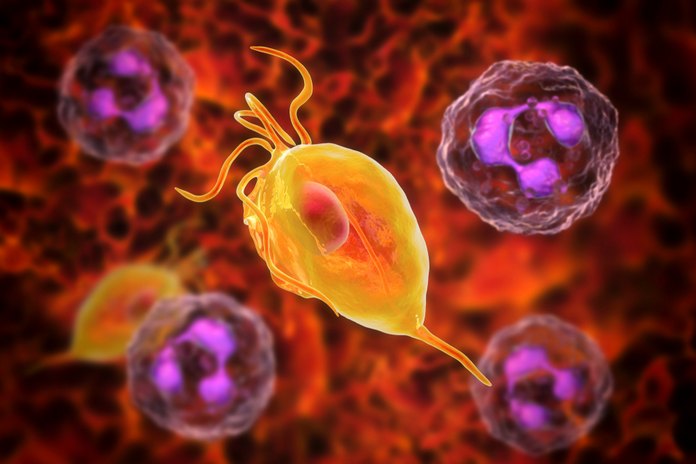What Trichomoniasis Causes & Risk Factors ?

Trichomoniasis has only one cause. It is an STI caused by a parasite called Trichomonas vaginalis. The parasite is passed from one person to another during sexual contact, including vaginal, oral or anal sex. The infection can be passed between men and women, women, and sometimes men. It can also be passed from mother to baby during childbirth. Trichomoniasis is not a curable disease, but it can be treated with antibiotics. (3)
The parasite infects the lower genital tract. In women, this includes the outer part of the genitals (vulva), vagina, opening of the uterus (cervix) and the urinary opening (urethra). In men, the parasite infects the inside of the penis (urethra).
The pathophysiology of trichomoniasis is not fully understood, but the parasite is thought to invade and damage the cells of the vagina and urethra. This can lead to inflammation, discharge, and discomfort. The time between exposure to the parasite and infection (incubation period) is unknown. But it’s thought to range from four to 28 days. Even without symptoms, you or your partner can still spread the infection.
Risk factors
There are several risk factors for developing trichomoniasis. They include having multiple sexual partners, being HIV positive, using intravenous drugs, and having a history of other sexually transmitted diseases. (4)
Young females
One in five American women will contract a sexually transmitted infection (STI) at some point in their lives. Trichomoniasis is the most common non-viral STI in females, affecting an estimated 1/9 million young females each year.
Though it affects both men and women, trichomoniasis is most commonly seen in young females. Treatment for trichomoniasis is simple and effective, and early diagnosis is crucial for preventing further complications.
Unprotected intercourse
There is a high risk of contracting the sexually transmitted infection (STI) trichomoniasis when having unprotected intercourse. Trichomoniasis is easily spread through sexual contact. It is important to be aware of this risk factor associated with unprotected intercourse and to take precautions to protect yourself from STIs like trichomoniasis.
Having multiple sex partners
Having multiple sex partners can increase your risk of getting trichomoniasis, a sexually transmitted infection caused by a parasite. Trichomoniasis passes itself from one person to another during sexual contact. It can cause genital itching, burning, and discharge in men and women. The best way to protect yourself from trichomoniasis is to use condoms every time you have sex. If you think you might have trichomoniasis, see your doctor for treatment.
Being HIV positive
There is a high prevalence of trichomoniasis among people who are HIV positive. In fact, studies have shown that anywhere from 25 to 50 percent of people who are HIV positive also have trichomoniasis. This is because the two diseases share some common risk factors, including having multiple sexual partners and being sexually active at an early age.
People with HIV AIDs are more susceptible to developing trichomoniasis because their immune system is already weakened. This makes them more likely to experience symptoms such as vaginal discharge, pain during sex, and itching and burning in the genital area.
If you are HIV positive and you develop trichomoniasis, it is important to get treated right away. Left untreated, the infection can lead to further health complications, including an increased risk of contracting other sexually transmitted infections.
African American women
African American women are disproportionately affected by trichomoniasis, a sexually transmitted infection caused by the parasite Trichomonas vaginalis. While trichomoniasis can affect anyone who is sexually active, it disproportionately affects African American women. A study found that African American women are more than twice as likely to be infected with T. vaginalis as white women.
There are several reasons for this disparity. One reason is that many African American women lack access to health care and screening services. Another reason is that African American women are more likely to have multiple sexual partners, which increases their risk of exposure to the parasite. Trichomoniasis can cause a variety of symptoms, including itching, burning, and discharge from the vagina. Left untreated, it can lead to serious health complications.
Diabetes
A recent study and clinical trial has found that people with diabetes are twice as likely to develop trichomoniasis. It is estimated that there are more than 7 million people with diabetes who develop trichomoniasis each year around the globe.
There are several possible explanations for why people with diabetes are more likely to develop trichomoniasis. The study looked at data from more than 2,600 people with diabetes and more than 9,200 people without diabetes. The researchers found that people with diabetes were two times as likely to develop trichomoniasis as those without diabetes. They also found that people with type 2 diabetes were particularly at risk for developing trichomoniasis.
Using intravenous drugs
One risk factor for trichomoniasis is using intravenous drugs. Drug use increases the risk of contracting trichomoniasis because it can increase the number of sexual partners a person has and also makes it more likely that someone will have unprotected sex.
Having a history of other sexually transmitted diseases
If you have a history of other sexually transmitted diseases (STDs), you’re at an increased risk of also having trichomoniasis. STDs like chlamydia and gonorrhea can increase your susceptibility to trichomoniasis, so it’s important to get tested for all STDs regularly. If you’re infected with trichomoniasis, your partner is also at risk, so both of you should be treated immediately.
